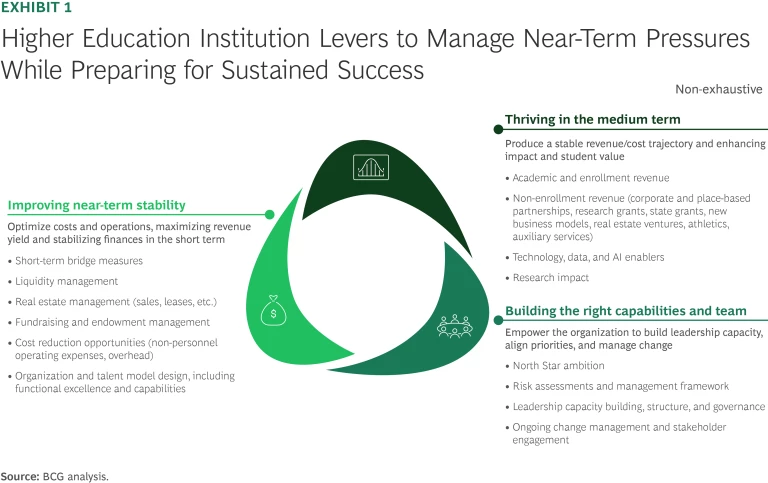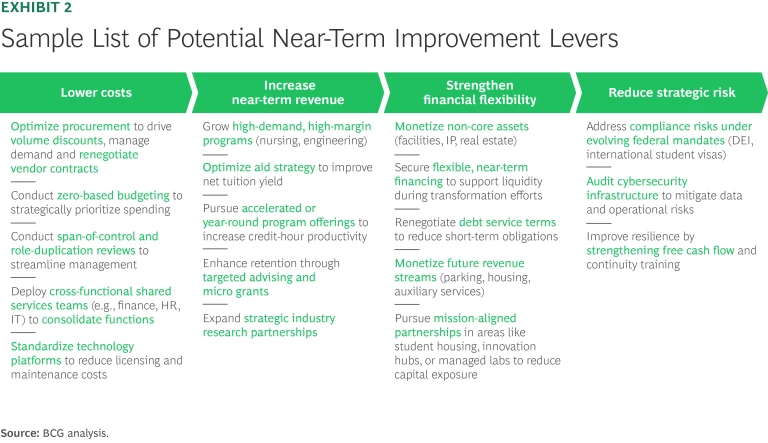From declining enrollments and rising costs to cuts in federal funding, the challenges facing universities these days are growing so prolifically and so quickly they could fill a library. Or bury it.
Universities are feeling the squeeze between lower enrollments and rising operational costs—which have long outpaced inflation. Moody’s predicts US schools will see a $750 billion to $950 billion rise in capital needs in the next ten years. In response to these mounting strains, some universities are cutting programs or even closing altogether (the Federal Reserve Bank of Philadelphia estimates that up to 80 universities may close by 2030). Others are seeking new revenue sources or raising tuition where possible. Adding to the growing pressure, federal executive orders and policy changes are complicating the landscape with potential cuts to funding, higher taxes, restrictions on international enrollment, and bans on established DEI programs.
While the challenges seem daunting, university leaders who move boldly to leverage the substantial advantages and opportunities at their disposal can use the current crisis to create strong, future-ready institutions. The reason that reinvention is a realistic moonshot—ambitious but achievable—and not a pie-in-the-sky dream rests on attributes that are as powerful and far-reaching as the various converging disruptors:
- Teaching and Research Reinvention. Advances in AI are unlocking new ways to enhance learning and discovery, personalize student experiences, and rethink the educator’s role.
- Efficient Operations and Support Systems. Institutions can harness data analytics, automation, and agile processes to streamline back-office functions, enhance service delivery, and enable faster, evidence-based decision making.
- Strategic Institutional Assets and Partnerships. Universities’ intellectual capital, brand equity, and stakeholder trust are potential catalysts for innovation that can be multiplied through partnerships with government, nonprofit, industry, and community players.
By using these strengths, higher education institutions can craft a strategic reinvention that reshapes how they deliver learning and demonstrate value to students and society.
A Constellation of Problems
The pressures facing higher education institutions are plentiful, but three are particularly challenging: the impending drop-off in enrollment, the arrival and integration of AI, and pressure from federal funding cuts and policy changes.
Looming Enrollment Cliff. Many of the economic and demographic trends affecting higher education have been building for years. Universities are facing an “enrollment cliff.” This is due in part to a declining college-age population: as birthrates have fallen, undergraduate enrollment declined by 15% from 2010 to 2021, according to the National Center for Education Statistics. In addition, students and their families are asking whether the ROI of a college education is worth the sky-high cost. Only 47% of Americans now consider a college degree worthwhile without loans, and the number drops to 22% when loans are involved, according to a 2024 Pew Research Center report.
Enrollment is falling as students and their families ask whether the ROI of a college education is worth the cost.
AI Disruption. The arrival of AI is revolutionizing every aspect of higher education, from the way classes are taught to skills employers look for to the way the administration operates. In the classroom, AI is overturning decades of teaching orthodoxy and challenging the way educators and students think about learning, bringing into question schools’ mission and identity. It is changing students’ expectations, and it is here to stay. According to a 2024 global survey by the Digital Education Council, 86% of students are already using AI in their studies.
AI has the potential to reshape every operational function as well. Administrations need to modernize outdated processes, including acquiring new skills and capabilities, to take advantage of AI tools that can execute complex tasks autonomously. The benefit is a leaner, faster, and more adaptive university—but new AI capabilities also come with requirements for new talent and organizational modernization.
Federal Pressure and Funding Cuts. Along with changing macroeconomic forces, each day seems to bring a headline about increased federal pressure on higher education. Government freezes of federal grants are already impacting prominent institutions. Stricter immigration policies and proposed bans on some segments of international students stand to deepen the enrollment problems. The 1.1 million international students in the US added an estimated $43 billion to the US economy in the 2023–2024 academic year, according to the Association for International Educators. This figure mostly includes spending on tuition and housing; and it doesn’t reflect the longer-term economic impacts from students who remain in the US to start careers and launch companies.
Proposed budget cuts to the National Institutes of Health, National Science Foundation, and similar agencies may destabilize the research engine of higher education. Direct losses in grant funding jeopardize ongoing research and faculty retention, while additional effects—such as reduced innovation pipelines and fewer research assistantships—challenge institutional competitiveness and student opportunities.
A BCG analysis estimates the potential impact of the combined economic and federal policy changes on an illustrative university (with a $1.5 billion operating budget, 10,000 to 15,000 students, and a $400 million to $500 million research portfolio) as ranging from $125 million to $250 million annually.
What Bold Leadership Looks Like Now: Business Model Innovation Levers
With universities facing a financial reckoning of this magnitude, what is required is not incremental adaptation but a strategic reinvention of the business model, shifting from high-fixed-cost structures that are dependent on enrollment and federal research funding to more agile, modular, and mission-aligned platforms.
Universities can develop effective change programs by focusing in three areas: improving near-term stability, thriving in the medium term, and building the right capabilities and team. (See Exhibit 1.)

Improving Near-Term Stability
Important short-term steps that can generate quick wins and momentum include cutting costs, finding new revenue sources, increasing financial flexibility, and reducing strategic risk. (See Exhibit 2.) There are numerous, finance-stabilizing steps that can make positive impacts in areas from cash flow and liquidity to fundraising and endowment management.
BCG has partnered with a range of higher education institutions to deliver rapid and sustained financial improvements. For one midsized university, this resulted in over $100 million in annual bottom-line impact through a comprehensive approach encompassing cost reduction, strategic enrollment growth, and mission-aligned partnerships.

Stay ahead with BCG insights on the public sector
Thriving in the Medium Term
In the medium term, universities need to stabilize revenue and cost trajectories and enhance value for students. Levers in this frame include academic and enrollment revenue; non-enrollment revenue such as research grants, athletics, and new business models; and better use of AI and other technology enablers.
Increase relevance for students. Students and employers increasingly expect education to prove its value in clear career-based outcomes, applied learning, and job-aligned credentials. A change agenda can include:
- Diversified course offerings and academic revenue sources, including a range of teaching modalities (such as online, hybrid, executive education)
- Strategically focused, high-ROI curricula aligned with employer needs and emerging fields (like data science, cybersecurity, health care, and advanced manufacturing), integrated experiential learning, and partnerships to deliver strong employment outcomes
- Sophisticated enrollment, discounting, and retention management measures, including data-driven segmentation, optimized pricing strategies, and targeted, technology-supported student support (such as advising) to improve yield and retention
BCG has worked with universities to help create successful strategies to broaden applicant pools; for example, one institution increased outreach to first-generation college students, growing enrollment by more than 50%. Other programs have helped universities optimize course offerings by redesigning the course catalogue to shift the mix toward subjects in greater demand and refining course schedules to improve faculty utilization, saving millions of dollars in annual costs.
Become an AI-Powered Organization. Universities can take a cue from leading companies that use AI-driven personalization to tailor outreach to prospective students and potential donors. Emerging tools—such as GenAI-powered virtual assistants that proactively guide students through complex decisions using predictive analytics—can provide real-time, contextualized support across admissions, financial aid, and academic advising. To fully capitalize on these innovations, faculty, advisors, and administrators should be trained to collaborate with AI systems, allowing them to shift from routine administrative tasks to more strategic, high-impact responsibilities.
Universities can take a cue from leading companies that use AI-driven personalization to tailor outreach to prospective students and potential donors.
AI has also entered the curriculum. Over 100 universities have instituted an AI-related credential, and AI-related degrees increased 120% between 2011 and 2023. Ohio State has launched an AI fluency initiative that embeds AI into core undergraduate requirements and majors, so that students graduate equipped to apply AI tools and applications in their fields. Institutions such as UC Berkeley, Florida, MIT, and University of Michigan have invested nearly $2.5 billion in AI research infrastructure to lead in next-gen discovery. Those without modern AI and computing offerings risk declining competitiveness and missed industry partnership opportunities.
These trends echo the broader shift toward “AI-first” organizational models that are emerging across the private sector, where companies in various industries are achieving rapid, capital-efficient growth by embedding AI into every layer of their operations. Firms are using automation, agentic workflows, and predictive analytics to achieve KPIs such as 90% lower customer acquisition costs and 25 to 35 times higher revenue per employee than traditional models.
AI-first organizations are increasingly using real-time dashboards to drive data-informed decision making. In the higher education context, such digital tools can connect financial, academic, and public-value metrics for smoother administrative functioning. Dashboards can track return on investment by academic program, integrating tuition flows, costs, and post-graduation outcomes to inform resource allocation. They can also monitor academic health of the institution by tracking course completion rates, student engagement, and faculty effectiveness.
Create New Partnerships to Fuel Future Growth and Revenue. Medium-term strategies include increasing partnerships with public and private institutions based on innovation, economic development, and technology. Such alliances enable universities to leverage their intellectual leadership in cutting-edge fields while positioning themselves as economic engines for regional development. Among many examples:
- Purdue University is partnering with the State of Indiana’s Hard Tech Corridor by integrating applied engineering and technology programs, contributing to billions in public-private investment in the region. Between 2013 and 2024, the school’s total student population grew by approximately 38.5% to over 51,500 students, supporting a tuition freeze since 2013.
- Wichita State University’s Innovation Campus has partnered with aerospace and engineering firms, driving an estimated 63% rise in industry-funded research since 2018, reaching $171 million in 2023.
- The University of Michigan has partnered with Los Alamos National Laboratory and the State of Michigan to invest hundreds of millions of dollars in advanced computing capacity, positioning Michigan as a national hub for AI, materials science, and climate modeling.
- Clemson University, South Carolina State University, and the University of South Carolina are core members of the South Carolina NEXUS for Advanced Energy, contributing innovative test beds and assets on grid emulation and grid-scale battery innovation to advance the state’s clean energy transition and its federal designation as a Technology and Innovation Hub.
- Other schools are growing their mission-aligned revenue base by developing overseas campuses, co-op partnerships, professional master’s programs, and lifelong learning.
Partnerships with public and private institutions enable universities to leverage their intellectual leadership while positioning themselves as economic engines for regional development.
Building the Right Capabilities and Team
Lasting change begins with institution leaders asking: Without losing sight of our core strengths and mission, what are the capabilities and characteristics that we need to develop to create a competitive institution in the future? With an image of an ideal future-state as their North Star, universities can begin to create programs that build lasting traits like leadership capacity, talent standards, and a culture of continuous reinvention.
Build Future-Ready Leadership Capacity and Management Structures. One of the most important things an institution can do is to invest in the development of capable, future-ready leadership—both faculty and administration—through talent searches, executive education, and cross-functional training. They should cultivate diverse talent pipelines and embrace leadership models that prioritize collaboration, innovation, and resilience in the face of uncertainty.
Universities should also move from traditional hierarchies to agile, cross-disciplinary teams that can respond quickly to challenges and opportunities. Incentives should encourage entrepreneurial thinking within academic units to support new revenue streams such as micro-credentials, online programs, and industry partnerships.
Build Continuous Improvement Capabilities. Tomorrow’s successful universities will be those that embrace technology and modern management approaches. Agile methodologies enable fast-cycle improvements in programs, services, and policies. Using data analytics, administrators can create positive feedback loops—capturing student input, labor market trends, and employer signals, for example, to streamline delivery of programs, student services, and other operations. Digital simulations can help pilot initiatives by testing new delivery models or staffing structures, improving the chances of implementation success.
Change Management and Stakeholder Engagement. One of the most important success factors for an ambitious change agenda is to generate support and buy-in from stakeholders and constituencies. In the current volatile environment, understanding sensibilities and managing expectations is critical.
Universities need a structured change management program that embeds strategic planning, stakeholder engagement, and a culture of adaptability. This involves establishing dedicated internal capacity, developing a multiyear roadmap with measurable goals, and actively involving diverse stakeholders through regular feedback and advisory mechanisms.
BCG has partnered with universities to realign leadership and governance around long-term goals and deploy a set of change management strategies that foster stakeholder trust and embed a culture of continuous transformation. For example, the firm helped a private not profit university redesign leadership roles and launch cross-functional teams anchored in a shared North Star—resulting in a 33% increase in first-time student enrollment and a 16% rise in net tuition revenue per student.
How Higher Education Leaders Can Get Started
As university leaders embark on their change journey, it is critical that reinvention remain grounded in institutional authenticity. To be successful, schools should align change efforts with their institutional DNA, avoiding generic models and relying on their core strengths.
For many schools, the opportunity window to make meaningful changes is narrowing. The immediate steps are about assessing weaknesses, strengths, and challenges and preparing the ground—especially stakeholders’ readiness and commitment—for the changes ahead.
Complete a current-state assessment. Assess the current financial state, evaluate organizational health and benchmark against peer organizations to identify unique assets and opportunities. Convene a team of leaders and stakeholders to stress-test financial risk scenarios—such as a 20% enrollment decline, or a 40% loss in federal funding—quantifying the impacts, and conducting scenario-based planning to assess risk appetite and acceptable trade-offs.
Evaluate opportunities and set targets. Identify and prioritize opportunities to enhance enrollment and non-enrollment revenue, reduce costs, and streamline the operating model. A central part of this effort should be establishment of a program management office to coordinate efforts, monitor savings and other KPIs, and improve accountability. Selected tactics from the menus above can be set in motion now. For example:
- Identify and implement near-term financial flexibility levers to lower costs or achieve new-revenue impacts within six to 12 months.
- Prioritize one or two “signature bets” that are rooted in the school’s mission and regional advantage (for example, connections with state or local players); for example, AI-supported student support models, applied workforce hubs, or industry R&D accelerators.
- Launch an AI-readiness assessment across academic and administrative units, including a cross-stakeholder working group with faculty, staff, trustees, alumni, and local partners to co-create a future-forward vision and support at-scale adoption.
Execute with excellence. Develop an action plan to support implementation based on the established vision and goals. Establish leadership roles and governance to guide the process and schedule with the project management office. Establish a broad-based change management program designed to communicate urgency, intent, and anticipated outcomes. Align university stakeholders (faculty, students, alumni, trustees, and regional leaders) around a clear narrative that supports a long-term reinvention agenda, not just short-term survival.
In the face of urgent challenges, university leaders can access a variety of levers and technologies, such as AI, to carry out meaningful change and build more resilient, future-ready organizations. Institutions that embrace reinvention and act decisively stand not only to increase their financial sustainability but also to strengthen their role in meeting evolving societal needs for talent and innovation.






